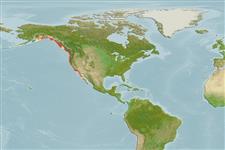Common names from other countries
Environment: milieu / climate zone / depth range / distribution range
Écologie
Pélagique; profondeur 20 - 180 m (Ref. 275). Tropical, preferred 13°C (Ref. 107945); 62°N - 26°N, 172°W - 112°W (Ref. 112699)
Eastern Pacific. Tropical to boreal.
Length at first maturity / Taille / Poids / Âge
Maturity: Lm ? range ? - ? cm Max length : 19.2 cm ML mâle / non sexé; (Ref. 94063); 17.9 cm ML (female); poids max. publié: 148.00 g (Ref. 94063); poids max. publié: 148.00 g
Caught by brails and night lights and pumps and night lights.
Life cycle and mating behavior
Maturité | Reproduction | Frai | Œufs | Fécondité | Larves
Mating and egg-laying occur at daylight (Refs. 94843, 94849), egg beds found at depths of 20-60 m (Ref. 94843).
Roper, C.F.E., M.J. Sweeney and C.E. Nauen. 1984. (Ref. 275)
Statut dans la liste rouge de l'IUCN (Ref. 130435: Version 2024-1)
statut CITES (Ref. 108899)
Not Evaluated
Not Evaluated
Utilisations par l'homme
Pêcheries: commercial
FAO - pêcheries: landings | FishSource | Sea Around Us
Outils
Sources Internet
Estimates based on models
Preferred temperature
(Ref.
115969): 8.2 - 11.9, mean 9.2 (based on 23 cells).
Résilience
Haut, temps minimum de doublement de population inférieur à 15 mois (K=1).
Prior r = 0.93, 95% CL = 0.61 - 1.39, Based on 2 data-limited stock assessments.
Vulnérabilité
Low vulnerability (10 of 100).
